
новая папка / Integrative Human Biochemistry_ A Textbook for Medical Biochemistry (PDF).pdf
.pdf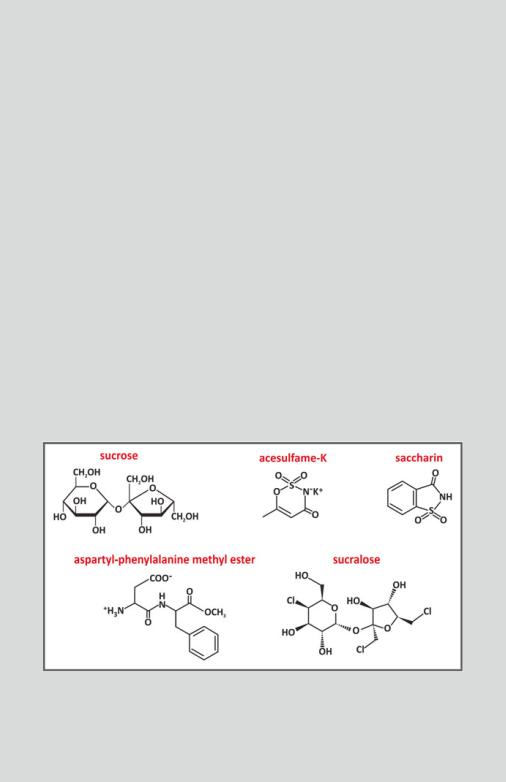
72 |
3 The Families of Biological Molecules |
Box 3.4: Sweeteners and Sugar Substitutes
The problem of popularization of high caloric diets stimulated the search for sugar substitutes. Sucrose, the most commonly used sugar in cooking, is a natural sweet molecule from which a certain amount of energy can be used by the human body after metabolization. However, there are molecules known as high-intensity sweeteners that have manyfold the sweetening power of sucrose. Saccharin, for instance, is approximately 300-fold sweeter than sucrose when equal quantities are compared. Aspartame and acesulfame-K are approximately 200-fold sweeter than sucrose. For sucralose the ratio raises to an impressive 600-fold. A specific chemical modification in aspartame, advantame, grants an impressive 20,000-fold increase in sweetness relative to sucrose. Therefore, much less mass of sweetener is needed to achieve the sweet taste of a food or beverage. Even though the “caloric content” of a unit mass of the molecule may be equivalent to sucrose in some cases, the total amount used is several orders of magnitude less and the total calories in the diet drops drastically.
The chemical structure of sucrose and most artificial sweeteners are very different. Sucrose is a disaccharide composed of the residues of the monosaccharides glucose and fructose. Sucralose is prepared from sucrose via the substitution of three hydroxyl groups for three chlorides. Saccharin and acesulfame-K have much different structures. Aspartame is the methyl ester of the dipeptide L-aspartyl-L-phenylalanine.
The molecular structure of sweeteners must be such that they bind to a specific receptor molecule at the surface of the tongue. The receptor is coupled to a G protein (see Sect. 5.4), which dissociates when the sweetener binds to the receptor. This dissociation leads to the activation of an enzyme
(continued)

3.2 Saccharides and Their Polymers and Derivatives |
73 |
Box 3.4 (continued)
that triggers a sequence of events resulting in signals that are carried to and interpreted by the brain. The sweetness perception depends on fine details of the interaction between receptor and sweetener. The importance of molecular shape to sweetness is illustrated by the case of aspartame, as its stereo isomer, L-aspartyl-D-phenylalanine methyl ester, has a bitter, not a sweet, taste.
There has been a long and continuous controversy about the impact of artificial sweeteners on health, which has driven a lot of research on the possible toxicity of their metabolic products. Saccharin has been very controversial and banned in some countries. In the body, aspartame is broken down into/absorbed as products that include aspartate, phenylalanine, and methanol. Phenylalanine is toxic to individuals with phenylketonuria, a genetic disease wherein individuals cannot process phenylalanine. Products containing aspartame must therefore be labeled for phenylalanine. Aspartame’s breakdown products—phenylalanine and aspartate, as well as methanol and its breakdown products formaldehyde and formate—are a matter of debate. Regardless of the controversies and limitations in their use, artificial sweeteners have an important role in the improvement of the quality of life of diabetics, who are limited in the consumption of sucrose and other saccharides.
or oses are therefore the preferred nomenclatures for biochemists although “carbon hydrates”, or carbohydrates, in short, and “sugars” are commonly used in closely related areas such as nutrition, for instance.
Saccharides are the most abundant biomolecules and owe this ubiquity to their reactivity and structural plasticity, which enable a great variety of functionalities, including energetic storage, cell communication, and cell protection against mechanical aggressions and dehydration. In order to understand such structural plasticity and the functionalities arising from it, one has to start with the basic chemistry and reactivity of saccharides. Although this is a wide and complex area in the realm of biochemistry, we will devote ourselves to the understanding of the most important saccharides in human biochemistry only. One will stick to the basics of this fascinating world for the sake of clarity and focus on processes that are foundational for other medical disciplines such as histology and physiology.
The simplest conceivable saccharides have three-carbon chains, i.e., they are trioses (“tri” for three carbons, “ose” for saccharide). Depending on the position of the carbonyl group, C=O, which may be terminal (aldehyde) or not (ketone), the saccharide is an aldose or a ketose. In the specific case of trioses, only glyceraldehyde and dihydroxyketone are possible (Fig. 3.15). But even in these cases, two kinds of common chemical reactions in nature are possible: esterification and reduction (Fig. 3.16).
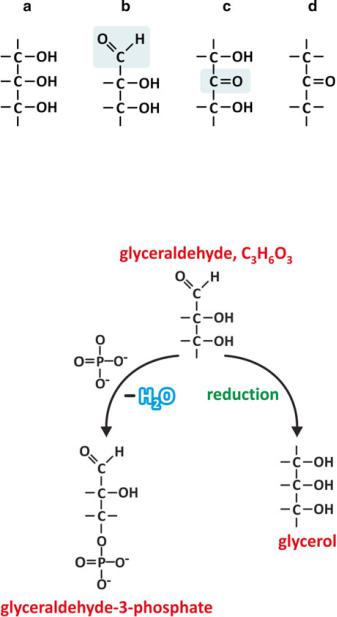
74 |
3 The Families of Biological Molecules |
Fig. 3.15 Glycerol [(a); also in Fig. 3.4d] is related to an aldehyde, glyceraldehyde (b), which has a ketone isomer, dihydroxyketone (c), which in turn is related to a ketone (d), dimethyl ketone. The aldehyde and ketone groups of glyceraldehyde and dihydroxyketone are highlighted in the chemical structures (b) and (c), respectively, by a shadowed box
Fig. 3.16 Glyceraldehyde may be reduced to glycerol upon chemical reduction of the C=O group in carbon 1 (carbons are numbered starting with the one from the carbonyl group, similarly to fatty acids, in which carbons are numbered starting in the carboxyl group). Phosphoric acid (HPO42−) may react with carbon 3, for instance, to form an ester, glyceraldehyde-3-phosphate. These are examples of very frequent reactions involving saccharides
The chemical structure of glyceraldehyde deserves close attention as its central carbon (C2) has four different substituents (i.e., it is bound to four different atoms or groups of atoms), being referred to as a chiral carbon or chiral center. Imagine the permutation of the H and OH substituents, for instance. A different molecule results from this switch (Fig. 3.17).
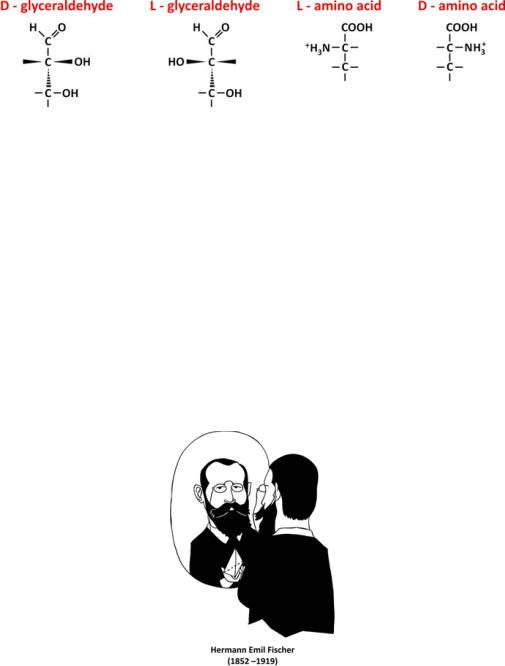
3.2 Saccharides and Their Polymers and Derivatives |
75 |
Fig. 3.17 L- and D-glyceraldehydes are mirror images. The same nomenclature was extrapolated to amino acids (alanine is shown as example)
Although having the same elemental composition and very similar structure, both molecules cannot overlap because the orientation in space of the H and OH substituents is different. The difference is clear if the molecule is represented in a 3D perspective. A closer look reveals that both molecules are mirror images of each other, i.e., they are enantiomers. To distinguish between both enantiomers of glyceraldehyde, one is named “L,” and the other is named “D.” These labels were arbitrarily assigned by Emil Fischer but are used to name saccharides and amino acids by extrapolation from glyceraldehyde (Fig. 3.17): D stands for dextro (right in Latin) and refers the structure having the OH group in the chiral carbon to the right when it is projected toward the observer; L stands for levo (left in Latin) and refers the structure having the OH group in the chiral carbon to the left when it is projected toward the observer.
In chemistry research, there are two other nomenclature conventions for enantiomers independent from each other: the R and S system, which is based on a classification of the substituent group based on the atomic number of atoms bound to the central atom (chiral center), or the + and − system based on optical activity, i.e., on the direction of rotation of incident plane polarized light. Symbols + and − are sometimes replaced by d- (dextrorotatory) and l- (levorotatory) but d- and l- are easy to confuse with D- and L- and prone to misunderstanding. Both systems are more robust than Fischer’s D- and L- because they are not dependent on the compari-
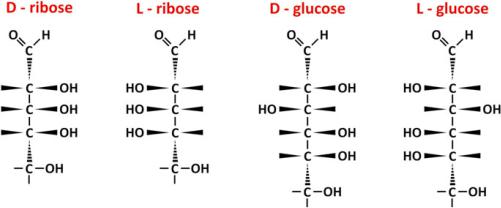
76 |
3 The Families of Biological Molecules |
son with glyceraldehyde. Chemists tend to use R/S or +/− but biochemists are still “attached” to the D/L system for a simple reason: chiral diversity among biological saccharides and amino acids is very restricted. By far the most abundant saccharides in human biochemistry are D-. Interestingly L- is the preferred form in amino acids. Natural evolution favored one form specifically probably because it is simpler to have only one form as the building block for saccharide polymers (polysaccharides) and amino acid polymers (proteins). A small protein with 100 amino acid residues that could be D- or L- would have 2100 different possible isomeric structures. Because only L-amino acids are used, only one isomeric form is allowed. Why specifically L-amino acids and D-saccharides and not the other forms? It is not clear; probably it originated from originally random processes that later propagated and converged by evolution into the specific enantiomers found in nature nowadays.
When longer carbon chains are considered, more complex saccharides are possible depending on the:
1. Length of carbon chains
2. Position of the carbonyl group in the carbon chain 3. Number and location of chiral centers
Although many different saccharides can be found in human body, pentoses and hexoses are the most frequent in metabolic processes so we will now focus on these molecules, namely, ribose and glucose (Fig. 3.18).
Fig. 3.18 D- and L-isomers of ribose (pentose) and glucose (hexose). D-forms are the more relevant forms in nature
Aldoses such as glyceraldehyde, ribose, and glucose react with water, forming a hydrate. This happens at the C=O group because the oxygen atom attracts the electrons leaving the C atom deficient in electrons, therefore prone to interact with the electrons of water oxygen (Fig. 3.19). The reaction is reversible, so
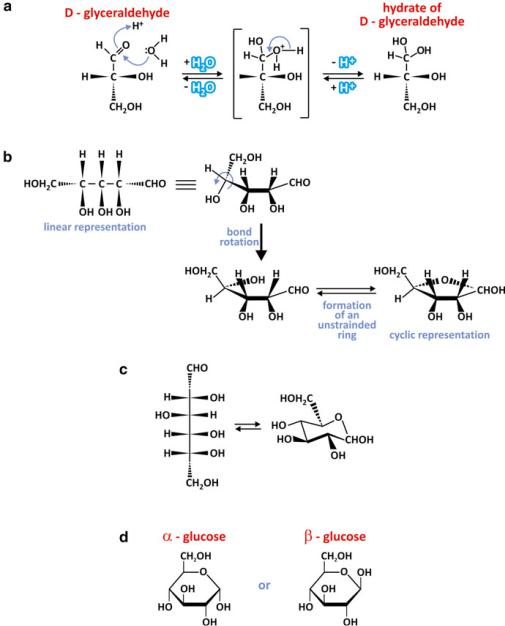
3.2 Saccharides and Their Polymers and Derivatives |
77 |
Fig. 3.19 Hydration of glyceraldehyde forms a hydrate (a). This reaction is reversible so glyceraldehyde coexists with its hydrate. The carbon originally present as a carbonyl group is the only carbon with two bonds to oxygen. A similar reaction may occur intramolecularly in pentoses (b) and hexoses (c). Panel (b) shows in detail the reaction of C=O (C1) with the OH group in C4, analogous to hydration. A cyclic pentose is thus formed. As with hydration, the reaction is reversible and both forms coexist, although the cyclic form is more abundant. The cyclic form of the hexose glucose is not planar as ribose is, as the molecular hexagon is flexible and adopts other conformations, such as the “chair” conformation (c). Cyclization results in the formation of two anomers (d) because the OH group formed at C1 may be placed on two different sides of the newly formed molecular ring: in the !-anomer the OH group in C1 is in the opposite side of the plane of the ring relative to the terminal carbon, C6 (–CH2OH) and in the "-anomer they are both at the same side. Both the “chair” (c) and the more simplistic planar (d) representation of hexoses is used in this book
78 |
3 The Families of Biological Molecules |
aqueous solution of aldoses contains mixtures of their aldehyde and hydrate forms. Nevertheless, pentoses and hexoses may react intramolecularly in a way that is similar to hydration. Because the carbon chain is able to bend and is dynamic (similarly to saturated aliphatic chains in lipids), the carbonyl group may contact alcohol groups (OH—hydroxyl) in the same molecule and react with it. The result is the formation of a cyclic molecule by the conversion of the carbonyl group in a hemiacetal group (Fig. 3.19). The cyclization is reversible, and in cells, the cyclic forms of ribose and glucose coexist with the linear forms, but the cyclic forms are dominant. Upon cyclization, two enantiomers are formed because the hydroxyl group in C1 may be linked to any of the two sides of the plane of the ring: in the !-anomer the OH group in C1 is in the opposite side of the plane of the ring relative to the terminal carbon, C6 (–CH2OH), and in the "-anomer, they are both at the same side. Glucose adopts a “chair” conformation at variance with the strict planar ring of ribose (Fig. 3.19), but ! and " anomers exist the same way. The existence of the enantiomers has drastic implications in the polymerization of hexoses.
3.2.1From Monomers to Polymers: Polysaccharides
Saccharides such as hexoses and pentoses may react with each other forming chains that may reach considerable size. Molecules built from the association of smaller molecules of a kind are generally named polymers, and polymers made of unit saccharides such as ribose or glucose are named polysaccharides. The units forming polysaccharides are referred to as monosaccharides. A covalent association of two monosaccharides is a disaccharide. Association of “few” monomers forms “oligosaccharides”; the size boundary between oligosaccharides and polysaccharides is not well defined.
Two monosaccharides may associate by dehydration. Take the example of two glucose molecules forming a maltose molecule (a disaccharide) by dehydration (Fig. 3.20). C4 in one molecule and C1 in the other become covalently attached by an acetal linkage or O-glycosidic bond. Water resulting therefrom is formed with the oxygen previously attached to C1. The reverse process is the hydrolysis of maltose into two glucose monomers, which although thermodynamically favorable, is a very slow reaction. In practice, when degrading enzymes are not present, the process my be be so slow that it is irrelevant.
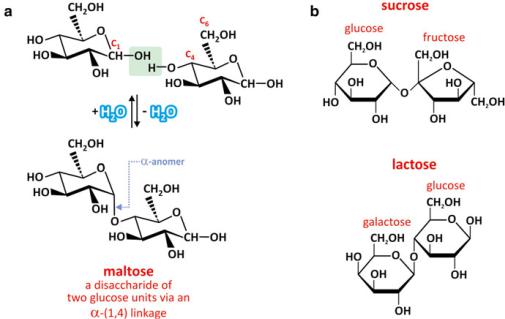
3.2 Saccharides and Their Polymers and Derivatives |
79 |
Fig. 3.20 Two glucose molecules may associate covalently by dehydration (a). When C1 in !-glucose (! anomer) reacts with C4 in another glucose, maltose is formed. Maltose is thus a disaccharide formed by linking two glucose molecules through an acetal or O-glycosidic bond. This bond is named “!-(1,4)” to stress that C1 in the ! anomer binds to C4 in the other molecule. Sucrose and lactose (b) are other examples of disaccharides. Both are formed from the conjugation of different constituent monosaccharides: glucose and fructose in the case of sucrose and galactose and glucose in the case of lactose. Sucrose involves an !-(1,2) bond, whereas lactose involves a "-(1,4) linkage
The stereo chemistry (i.e., the spatial orientation of the chemical groups in the molecule) is very important because the covalent linkage of two molecules imposes restrictions on the way molecules can move in space. Depending on whether monomers are ! or " anomers, different degrees of restriction arise. The flexibility of the conjugate is very much dependent on the enantiomers because the interaction between molecular groups in the disaccharide is very different (Fig. 3.21a). This effect is amplified in large polymers; polysaccharides may have a wide range of flexibilities, from extremely stiff and straight to coiled and deformable depending on the enantiomers used. Cellulose, for instance, is a glucose polymer formed with "(1,4) bonds that is extremely resistant mechanically, whereas amylose is an example of a flexible polymer formed by a !(1,4) backbone (Fig. 3.21b, c). Cellulose properties determined its evolutionary selection toward structural functions in plants, forming cell walls, which impacts in the macroscopic properties of wood. Amylose is a component of starch, a molecule that curls forming helices and is stored in plants for use in the energetic metabolism. Starch is the most common polysaccharide in human diet. Cellulose and amylose are striking examples of how apparently small details may actually determine profound differences in molecular properties and structures and therefore also in function.
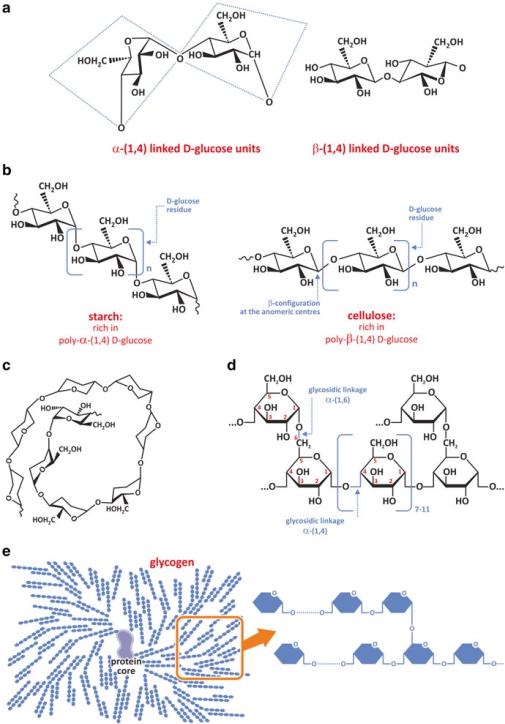
80 |
3 The Families of Biological Molecules |
Fig. 3.21 Two monosaccharides such as D-glucose forming a disaccharide (a) have very different restrictions to articulate and to move depending on whether the glycosidic bond is !-(1,4) or "-(1,4). When several monomers bind to form a polymer (b), successive !-(1,4) or "-(1,4) bonds confer distinct properties to the polymer: !-(1,4) bonds enable bending between monomers, which results

3.2 Saccharides and Their Polymers and Derivatives |
81 |
Carbon 6 is also available for reaction so linear polymers formed of C1–C4 chains may branch when C1–C6 bonds are also formed (Fig. 3.21d). Amylose turns into amylopectin when "(1,6) links are formed. Glycogen is the human storage polysaccharide and is very similar to plant amylopectin (Fig. 3.21e). They differ only in the frequency of branching and average size of !(1,4) segments. The advantage of having glycogen as energy storage relative to a linear (unbranched) polysaccharide relates to the fact that glycogen is enzymatically degraded by saccharide hydrolysis of the terminal units. A branched molecule has several termini which can all be degraded at the same time, making glucose readily available at high rate.
Depending on their chemical composition and stereochemistry, polysaccharides found in nature have one of three functions: (1) structural/mechanical protection,
(2) energy storage, and (3) water-binding (protection against dehydration). Several examples are listed in Table 3.3. Hyaluronic acid is particularly interesting for its involvement in connective tissue. Its interest extends from biochemistry to histology. Hyaluronic acid, a polysaccharide with sulfate groups (SO42− has similar properties to PO42−), forms an extracellular mesh with collagen, making up a flexible but resistant hydrated histological structure (Fig. 3.22).
Table 3.3 Examples of the function of polysaccharides found in nature: structural (Str), energy storage (Sto), water-binding hydration (Wat) (D-Glc, D-glucose; D-GlcNAc, N-acetyl-D- GLUCOSAMINE; D-GlcUA, D-glucuronic acid)
|
Monosaccharide |
Monosaccharide |
|
|
|
Main |
Polysaccharide |
1 |
2 |
Bond |
Branching |
Location |
function |
Bacteria |
|
|
|
|
|
|
Peptidoglycan |
D-GlcNAc |
D-MurNAc |
"-(1,4) |
– |
Bacterial |
Str |
|
|
|
|
|
wall |
|
Dextran |
D-Glc |
– |
!-(1,6) |
!-(1,3) |
Capsule |
Wata |
Animals |
|
|
|
|
|
|
Chitin |
D-GlcNAc |
– |
"-(1,4) |
– |
Insects, |
Str |
|
|
|
|
|
crabs |
|
Glycogen |
D-Glc |
– |
!-(1,4) |
!-(1,6) |
Liver, |
Sto |
|
|
|
|
|
muscles |
|
Hyaluronic acid |
D-GlcUA |
D-GlcUA |
"-(1,4) |
– |
Connective |
Str, Wat |
|
|
|
"-(1,3) |
|
tissue |
|
aCapsular materials like dextrans may be overproduced when bacteria are fed with saccharides to become reserves for subsequent metabolism
Fig. 3.21 (continued) in curled polymers such as amylose (c) and the stiffer "-(1,4) links between monomer favor linear straight polymers, such as cellulose. Therefore, cellulose is found in structural elements of plants, while amylose is used by plants as energy storage. Humans also use a poly-!-(1,4) saccharide as energy storage. Periodic !-(1,6) branching every 10 residues, approximately, further enables a globular organization of this polysaccharide (d). The final result is a regularly branched polymer of D-glucose named glycogen (e). Glycogen synthesis is initiated by a protein and elongation requires several enzymes (see Sect. 8.2)
